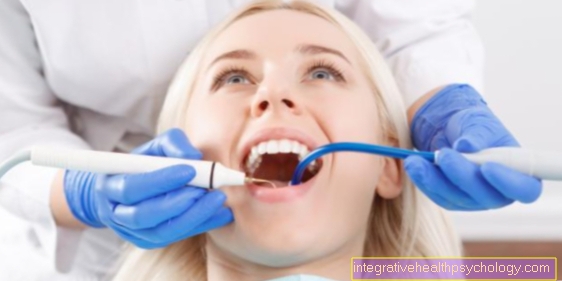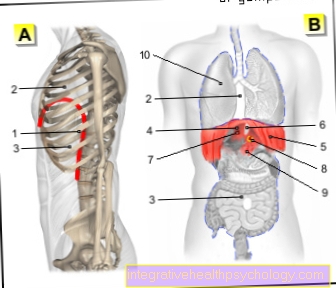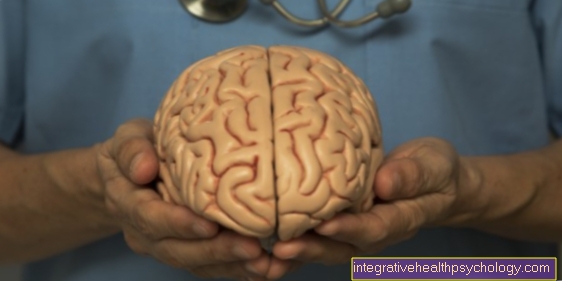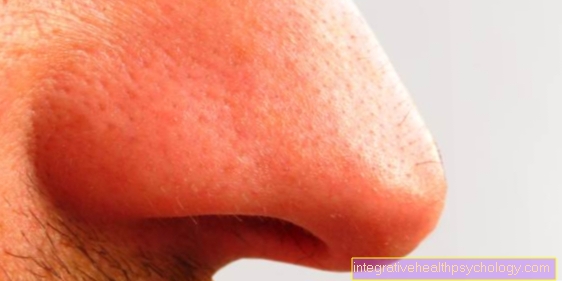Abscess on the tooth
definition
An abscess on the tooth is an encapsulated collection of pus in the tissue of the oral mucosa that occurs as part of an inflammation. The origin of the inflammatory process can be the tooth itself or the surrounding tissue. An abscess can only be treated surgically.

Symptoms - an overview
These symptoms are common with an abscess on the tooth:
- Redness, swelling, warming
- Pain when tapping the tooth
- Throbbing pain, especially at night
- Pain-free intervals
- Gum inflammation with pus
- Jaw pain
- Pressure / tenderness below the tooth
- Tooth is loosened
- Pain when chewing
- "Thick jaw"
Symptoms in detail
If the tooth has died and is the cause of the pain, then in most cases it reacts with pain when the tooth crown is carefully tapped. The patient feels throbbing pains that peak at night and often flatten out again during the day. This is due to the lying position, which one assumes at night.
Read more on the topic: Toothache at night
The head is supplied with more blood while lying down, which also puts more pressure on the already sensitive tooth and the taut tissue (because the pus capsule also requires space) and he reacts with severe pain.
Pain relief is felt after cooling the affected area, while warmth increases the pain. In this case, one can blame the increased blood flow when warm for the pain and the reduced blood flow due to the cold for the relief.
The tooth itself may no longer lie firmly in the jawbone due to the accumulation of pus under the tip of the root and may be loose and wobble slightly, or appear elongated. In this case, the accumulation of pus below the tooth has pushed it out of its bone compartment.
Now every time you bite, the antagonistic teeth put pressure on the tooth and the patient can only eat or close his mouth correctly with great difficulty.
Some patients feel great pain when pressure is applied to the jaw at approximately the level of the root tip. This can also be an indication of an abscess.
Read more on the subject at: Pus in the jaw
Very often you can see an abscess in a patient without even looking in the mouth. A swollen cheek can be a very good indicator, as can palpation of the lymph nodes in the neck area, which in the case of an abscess are swollen and tender.
Abscesses on the lower jaw are particularly noticeable, as they tend to swell over a large area. They can affect the whole neck and make breathing difficult.
See also:
- Abscess in the lower jaw
- Abscess in the jaw
Why does the pain subside and come back?
Typical symptoms of an abscess are the five signs of inflammation. Increased temperature, reddening of the skin, swelling of the soft tissues, loss of function and pain. Sometimes, however, it can also happen that pain is completely absent or only occurs temporarily and then recedes into the background.
Pain is caused by the increasing tissue pressure due to the inflammation. If they disappear again, this is a sign that the tissue pressure has decreased again.
The inflammation has then mostly broken through into the surrounding soft tissue and has more opportunities to spread there. After a while, however, it can become painful again. Because the pressure also rises in the soft tissue at some point, but only later because there is more space for fluid to accumulate there. Since the inflammation can no longer spread here at some point, a swelling forms, which is visible from the outside.
The freedom from pain is therefore usually only temporary and also very individual. Although the majority of those affected complain of pain from an abscess, it is not unusual if it does not occur. If in doubt, always go to the dentist, even if nothing hurts, as an abscess does not heal on its own and can become very large without being noticed.
You might also be interested in this topic: Fistula on the tooth
Abscess on the tooth with pus
The pus is caused by inflammatory tissue breakdown and the demise of a special subgroup of white blood cells, the neutrophils, which previously tried to fight the bacteria but did not make it.
Pus is a highly infectious tissue secretion that is yellowish to greenish in color and has an unpleasant odor. The type of bacteria that is primarily responsible for the formation of purulent abscesses in the oral cavity are the staphylococci.
You might also be interested in this topic: Inflammation of the gums with pus
therapy
Surgical intervention is always necessary to fully treat an abscess on a tooth. In teeth sensitive to knocking pain, with bone loss visible in the X-ray, the first measure to relieve pain is to open the tooth so that the pus can drain through the tooth.
As long as pus is still flowing, the tooth should be left open. This means that if the pus flow has not decreased after about 20 minutes, the patient may be sent home with an open hole in the tooth and further treatment will only take place the next day or the day after that. In the vast majority of cases, the pain suddenly subsides after the pus has drained, as the permanent pressure disappears.
The tooth is provided with a medicinal insert and the opening is closed with temporary filling material. After the inflammation has subsided, a complete root canal treatment must then be carried out.
The procedures described above are performed under local anesthesia. A conduction anesthesia is placed in the lower jaw and the relevant tooth in the upper jaw is encapsulated using an infiltration anesthesia.
If the abscess is very advanced, anesthesia may not be effective enough. The anesthetic uptake correlates with the pH of the tissue. If there is an inflammation, the tissue's pH value drops and the anesthetic can no longer be sufficiently absorbed. An attempt is made to achieve a sufficient depth of anesthesia nonetheless by injecting afterwards and using stronger agents.
It is not possible to simply treat an abscess with medication. At the very beginning of the inflammation you can try to numb the pain with medication and avoid the formation of pus, but a root canal treatment is also essential.
If periodontitis is the cause of the abscess, an attempt is made, also under local anesthesia, to clean the gingival pockets and drain the pus. In general, the acute infection must always be brought to a standstill before further treatment measures can be taken.
Deep pockets that have formed due to the abscess may have to be reduced in size by periodontal surgery to ensure stabilization of the affected tooth in the jaw.
Untreated abscesses that can continue to grow unmolested will eventually break through their pus capsule and the pus is distributed in the body together with the bacteria it contains. Then an immediate blood test and an inpatient hospital stay are the normal procedure.
Read more on the topic: Dental pain elimination
When does the abscess on the tooth need to be cut open?
An abscess should be opened / cut open as soon as possible. However, this is only possible when the inflammation has progressed so far that pus has also formed. As soon as pus has formed, it can no longer drain away by itself or be broken down by the body.
Without treatment, more and more will form and the abscess cavity will become larger and larger due to the increase in pressure.
Depending on the location, it can then spread in different directions and cause severe damage without treatment. Cutting open allows the pus to drain and then heals the inflammation. Usually a root canal treatment or pulling the guilty tooth is necessary afterwards in order to ensure complete and lasting freedom from pain.
The earlier the abscess is recognized and treated, the higher the chances of recovery. Further spread is unlikely with adequate treatment.
Can I open the abscess myself?
No. In any case, it is not recommended to open an abscess on the tooth itself. On the one hand, you will never be able to work as sterile at home as the doctor in practice. The risk that bacteria migrate into the wound and the inflammation - possibly. stronger than before - flaring up again is immense. Especially since you cannot create 100% drainage at home without special equipment. The opening then closes again within a short time and the abscess fills again.
On the other hand, the abscess may be in a very unfavorable position, for example near a blood vessel or nerve. When opening, these can be hit and permanent damage occurs. Only the dentist knows exactly where the vessels are and will protect them in the event of an abscess opening. You should therefore refrain from self-treatment and consult a specialist as soon as possible.
Do you have to pull the tooth with an abscess?
As a rule, a tooth is only extracted after abscess formation if all other therapy attempts have previously failed.
This includes primarily the relief incision of the abscess and a root canal treatment, provided the tooth still contains inflammatory nerve tissue. If the abscess has arisen despite an intact root filling, an attempt is made to perform a root resection in addition to the incision of the abscess and, if necessary, to seal the root filling from below, retrograde. With a root tip resection, the tip of the tooth root is removed surgically.
After a failed apicectomy, the practitioner can decide whether a second attempt at this therapy makes sense or not. If this therapeutic approach has also failed, the tooth is only then extracted as the last resort.
Read more on the subject below: Tooth extraction- you should know that
Apical resection
A root tip resection is necessary in the presence of an abscess if a completed root canal treatment with a root filling has failed and the tooth continues to cause discomfort despite the optimal length of the root filling. A roundish lightening around the tip of the root of the affected tooth becomes visible on the x-ray.
In this case, the swollen tissue is surgically detached from the bone in order to reach the root tip of the affected tooth and then shortened by 2 mm. The area is cleaned and disinfected, if necessary the root filling is additionally sealed from the root tip. After the bone and tissue have been cleaned up, the site is sewn up and the wound is awaited to close.
If the tooth becomes symptom-free and the wound heals, the tooth can again withstand loads as a full member of the dental arch. However, if the inflammation returns and an abscess forms again, consideration should be given to having the tooth removed.
Find out more at: Root tip resection - when does it make sense?
Treatment of abscesses with antibiotics
Patients who require antibiotic protection should take ß-lactam antibiotics during the entire course of the disease in order to prevent the bacteria in the oral cavity from entering the entire body, especially the heart or brain, and leading to undesirable consequential damage.
These are patients with acute endocarditis, with immunodeficiencies and also people suffering from diabetes, since diabetes greatly slows down the healing of such inflammations and, in the case of diabetes, the body's self-healing powers are greatly reduced. In these patients, great care must be taken when giving anesthesia that too much anesthetic is not given during post-injection.
Patients without health problems do not need antibiotics after the procedure.
Antibiotics should only be given if the infection threatens to spread in the body. Often this is amoxicillin or clindamycin.
These broad spectrum antibiotics cover almost the entire spectrum of germs and thus kill pathogenic germs before they can cause damage in the body.
Home remedies for an abscessed tooth
Many home remedies are known for abscess treatment, but in most cases they only provide short-term relief. The home remedies only fight the symptoms, never the cause.
The healing power of the onion, which has an antiseptic effect if you chew a raw slice for several minutes, is very often used. Chamomile has antibacterial effects and can thus keep other pathogens away from an inflamed area. To do this, a strong tea should be boiled and then rinsed with it several times a day. Stinging nettle tea has anti-inflammatory and blood-purifying effects when taken in around three cups a day.
Causes - an overview
Possible causes for an abscess on the tooth are:
- Untreated severe inflammation of the gums
- Deep, untreated gingival pockets
- Inflammation of the periodontal membrane
- Root inflammation
- Inflammation of the alveolar bone
- Deep, untreated tooth decay
- Inflammation in the pulp (pulpitis)
Pulpitis
In order to determine the exact cause of an abscess in the oral cavity, it is first necessary to distinguish whether the inflammation is from the surrounding periodontium (Tooth supporting apparatus) or originates from the tooth itself.
Deep caries can destroy the tooth so badly that bacteria and germs get into the pulp and pulpitis (Tooth pulp inflammation ) can trigger. If the pulpitis is not treated very quickly and in the initial stage of the inflammation, the tooth inevitably becomes vital, i.e. it dies.
The pulp is located inside the tooth and its root. It contains nerve fibers and small arteries and veins that feed the tooth and keep it alive. If the pulp is inflamed or damaged, there is no endodontic treatment (Root canal treatment) past.
Read more on the topic: Root canal treatment
Root inflammation
In the following period an inflammation of the root tip of this tooth often develops, in technical terms "apical periodontitis". Normally the inflammation remains locally limited on the tooth, only in the rarest cases do the germs spread through the lymph nodes or the bloodstream in the body. Since this is possible, therapy is recommended as quickly as possible in order to avoid further damage.
Read more on the topic: Root inflammation
Periodontal disease
Sometimes the causes of an abscess are not to be found in the tooth, but in the surrounding periodontium. Marginal periodontitis is a fairly common disease and is the result of advanced and untreated gingivitis (Gingivitis). The bacteria and germs ensure that the bone that holds the tooth in the tooth socket retreats.
At the same time, deep gum pockets are created, as the gingiva is also inflamed and detached from the tooth. The tooth loses its grip and begins to wobble because it can no longer be firmly anchored in the jawbone. Once a bone has disappeared, it cannot be rebuilt. As a result of marginal periodontal disease, abscesses can develop that can be seen as a swollen cheek.
You may also be interested in this topic: Bump on the gum
Abscess on the tooth implant
Not only your own teeth, but also an implant can - but rarely - be affected by an abscess. Often this occurs immediately after the implantation and can then also originate from the surgical wound that has arisen. This is a major problem for maintaining the implant. Therefore, action must be taken quickly.
An antibiotic should be given to reduce inflammation. If pus has formed, the abscess cavity must be opened so that it can drain away. After healing, the doctor should take an X-ray to assess possible bone loss around the implant. Only then can he decide how to proceed. But if you take all precautionary measures, this course is rather rare.
Abscess in the lower jaw
Due to the dense structure of the bone in the lower jaw, almost all jaw abscesses occur here, while the upper jaw is hardly affected due to its softer bone. In the lower jaw, the abscesses are named according to their anatomical location (e.g. perimandibular abscess or submandibular abscess).
A bacterial infection on the tooth causes the body to form pus due to the failed defense reaction, which can spread in different directions from the tooth. Due to the tendency to spread, there is a risk of life-threatening complications such as sepsis.
Symptoms of this abscess are swelling with pain and a strong feeling of pressure, the mouth opening and swallowing ability may be restricted and the tooth is sensitive to chewing pressure. Extreme caution is required if swallowing problems and airway obstructions occur. Action must be taken immediately and the dentist, emergency service or the clinic visited to relieve the abscess and drain the pus.
Pressing or even piercing the abscess on its own must absolutely be avoided, as this will cause the pus bladder to burst open and the pus secretion to spread in the tissue.
Surgical opening and removal of the abscess by the dentist or oral surgeon has become a routine procedure these days and the following applies: the smaller the abscess, the more minimally invasive the procedure and the faster the healing process.
For therapeutic support, an antibiotic is usually prescribed to kill all bacteria as quickly as possible. The affected person can cool the affected area before and after the procedure in order to prevent the abscess from spreading and enlarging.
Learn more at. Abscess in the lower jaw
diagnosis
An x-ray shows a collection of pus at the tip of the root through a shadow. The area with the pus appears darker than the surrounding area and the tooth. However, not every shadow is caused by pus, caries and the pulp, for example, are also shown dark in the X-ray image. There are several types of x-rays that a dentist can take to help diagnose apex inflammation:
An OPG (Orthopantomogram) represents the entire dentition, the diagnosis of apical lightening is roughly possible here. If the inflammation is only in the early stages, it may not be seen exactly here, but advanced inflammation is very visible.
To clarify more precisely whether something can really be seen or if the patient only has pain in a single tooth, an EZA, a single tooth image, is often arranged. The advantage of this type of image is the level of detail and the low radiation exposure.
An abscess on the tooth in children
In children, an abscess often occurs as a result of a Treatment of caries on the milk tooth on. Since smaller children usually don't stay still for very long and are afraid of the dentist, the doctor often cannot remove all of the tooth decay. This can then progress further under a filling and in rare cases also cause abscess formation. If the dentist has to drill very close to the nerve, bacteria can possibly get into the tooth cavity and cause the same consequences.
Dangerous is an abscess here mainly because of the attachments of the permanent teeth. The collection of pus can cause this damage, in the worst case even so strong that the permanent tooth cannot be preserved or Malformations having. Therefore, an abscess should occur Treated toddler quickly to prevent worse consequences.
Duration of an abscess on the tooth
An abscess develops over a long period of time, so it is not possible to give a precise indication of the duration of this process. In most cases, the beginning is an inflammation of the tooth root or an infection of a wound, for example after pulling a tooth. If no further treatment is initiated, bacteria can multiply and pus forms after a while. At this stage it is called an abscess.
Simple abscesses can be opened under local anesthesia with a small incision along the gum line and the pus drained away. This treatment usually only takes a few minutes at the specialist. If deeper regions are affected or the abscess has become very large, a major surgical procedure must be performed. This is usually only possible in a clinic and is associated with an inpatient hospital stay of around 3-5 days.
This duration depends on the type of pretreatment and the urgency of the procedure. Since it is not always possible to open it from within the oral cavity, an incision must be made through the skin in severe cases. This can leave a small scar. Since it has to be ensured that the pus actually flows out, a plastic tube, also called drainage, is inserted into the abscess cavity. This must then be checked and rinsed daily until all of the pus has drained. Only then can the drainage be removed completely and the wound closed again, as otherwise bacteria could remain and a new flare-up occurs.
Recommendations from the editorial team
- Abscess in the jaw
- Abscess on the roof of the mouth
- Swollen gums
- Big cheek - what to do?
- Bump on the gum














.jpg)














